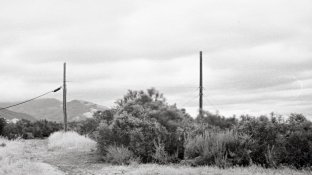Too Many Cameras
Member
About a year ago I picked up a 2,000 foot can labeled Kodak Vision 2383. It had been opened, but the film in it is not, I don't think, 2383. I'm trying to identify what it might be. Here's what I know:
- no edge markings (at all)
- ISO 1.6
- blue emulsion on one side only (unlike x-ray films I read about online)
- no anti-halation layer (I snipped a short unexposed section off and it's translucent)
- wrapped on a lab core
- standard 35mm film perforations (not the shape used for motion picture stock)
- slightly thinner than standard Kodak bases, but not as thin as polyester
- easy to cut with scissors (as opposed to polyester, which is not)
- film base is a slightly gray-brown color and the image is somewhat low contrast
- extremely fine detail
- no funky smell like old or nitrate films can get
I've developed this in D-76 and Microdol-X and both delivery fine results.
Here are a couple of sample pictures (Microdol-X):
![208[1].jpg 208[1].jpg](https://www.photrio.com/forum/data/attachments/52/52301-4247ea512818108b3c8535a5b08c0b28.jpg)


I've thought variously that it may be x-ray film, microfilm, 2383 (because it was in the box and has no remjet backing), or Eastman 5234 that has lost a couple of stops with age, or something I've never heard of. I'm hoping someone here knows enough about obscure film stock to point me in the right direction. I have XTOL and Dektol (XTOL made up) and can run a test of this exposed at ISO 6 and developed in XTOL, as Digital Truth suggests for 5234 this weekend, if that would be of use.
If it is 2383, would the magenta edge markings be lost during development as black and white negative film? Is it worth asking my local photo lab to run this as either E-6 or C-41? There's no remjet to muck up their machines.
Thank you, everyone, for help and suggestions. I'm hoping I can identify this film so I can use it better than I have been.
David
- no edge markings (at all)
- ISO 1.6
- blue emulsion on one side only (unlike x-ray films I read about online)
- no anti-halation layer (I snipped a short unexposed section off and it's translucent)
- wrapped on a lab core
- standard 35mm film perforations (not the shape used for motion picture stock)
- slightly thinner than standard Kodak bases, but not as thin as polyester
- easy to cut with scissors (as opposed to polyester, which is not)
- film base is a slightly gray-brown color and the image is somewhat low contrast
- extremely fine detail
- no funky smell like old or nitrate films can get
I've developed this in D-76 and Microdol-X and both delivery fine results.
Here are a couple of sample pictures (Microdol-X):
![208[1].jpg 208[1].jpg](https://www.photrio.com/forum/data/attachments/52/52301-4247ea512818108b3c8535a5b08c0b28.jpg)


I've thought variously that it may be x-ray film, microfilm, 2383 (because it was in the box and has no remjet backing), or Eastman 5234 that has lost a couple of stops with age, or something I've never heard of. I'm hoping someone here knows enough about obscure film stock to point me in the right direction. I have XTOL and Dektol (XTOL made up) and can run a test of this exposed at ISO 6 and developed in XTOL, as Digital Truth suggests for 5234 this weekend, if that would be of use.
If it is 2383, would the magenta edge markings be lost during development as black and white negative film? Is it worth asking my local photo lab to run this as either E-6 or C-41? There's no remjet to muck up their machines.
Thank you, everyone, for help and suggestions. I'm hoping I can identify this film so I can use it better than I have been.
David










